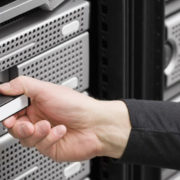We’ve Got Your Back(up)
It’s important to have a plan in place for when things go wrong. 21% of small business owners without a written disaster plan said they don’t have one because it’s not a high priority for them. These plans can be the deciding factor in whether a business survives or goes down with a disaster.
Luckily, your business has plenty of options when it comes to disaster recovery. There are 3 distinct types of backup recovery sites, each with their own benefits and drawbacks. These determine how quickly and effectively the next steps will get your business back up and running.
Taking a look at them will help you decide which is best suited for your organization.
Cold Site
What it is: A location reserved in the event of a disaster. Simply put, it’s empty space that you can rent. Companies configure this space to set up hardware such as servers, PCs, and even full employee workstations. It’s a space that’s reserved for you in the event of a disaster, but where you must supply all of the resources.
The good: Out of all the disaster recovery options, this is the cheapest. After all, you’re just renting out an empty space and waiting for the worst to happen. For very small businesses without a recovery time objective (RTO), this is a feasible option.
The bad: Cold sites require you to physically relocate on your own. That means you must wait for your employees to gather at the site, and then have someone on hand managing the technical aspects. To achieve reasonable levels of downtime, these sites require your backups and disaster recovery policies to be nearly flawless – an unrealistic expectation for most businesses.
Warm Site
What it is: Similar to cold sites, warm sites entail areas that companies may rent out. Unlike cold areas, these sites will have the barebones materials that most organizations need to keep operations running through a disaster.
The good: Though more costly than a cold site, warm sites are still within reach of many businesses. When comparing them to cold sites, they can significantly reduce the time it takes for operations to recover.
The bad: Warm sites still require the latest backups from an operational work environment to work properly. The devices and software may be there, but going without the latest backups means being stuck working from scratch. Often times, these warm sites will have some data backups to work from, but they may be days, weeks, or even months old.
Hot Site
What it is: The elite version of disaster recovery sites. Hot sites are kept current on a nearly 1:1 ratio with the true operational environment. Many of them use real-time synchronization to ensure that data is flowing at all times. In the event of a disaster, the hot centers will contain the latest versions of all files, programs, and even user profiles.
The good: Hot sites only allow the bare minimum of downtime. These sites are so meticulously maintained that it would seem like walking into a brand-new office. Productivity stays up, as well as ROI and all other operations.
The bad: Hot sites are by far the most expensive disaster recovery option. They’re typically far out of the range for small businesses in most industries. Many times, companies that simply can’t afford downtime will keep these on hand for skeleton crews to keep operations running as smoothly as possible.
Choosing the Right Site for You
Your organization will undoubtedly have a preference for one of the three sites, possibly with special conditions. Regardless of your choice, the best course of action for your disaster recovery plan is to partner with IT experts that can help you make your choice as well as set up the necessary connections for your site.
Our experts at Affinity are the perfect match for you. We’ve done our fair share of disaster recovery site planning and management – and we’re pretty good at it too.
Interested in learning more about how we can help you find the right fit for your disaster recovery?
Contact us to get started.











